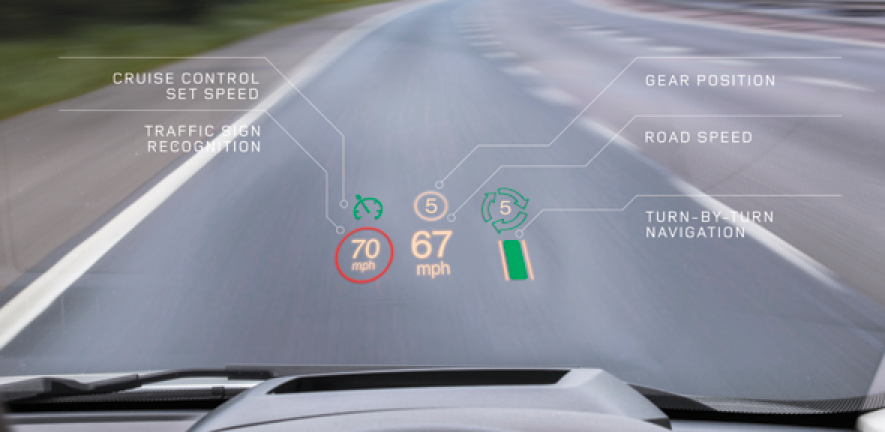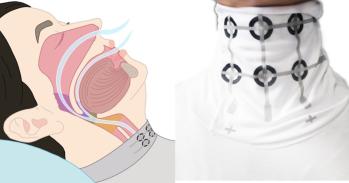
A ‘head-up’ display for passenger vehicles developed at Cambridge, the first to incorporate holographic techniques, has been incorporated into Jaguar Land Rover vehicles.
A ‘head-up’ display for passenger vehicles developed at Cambridge, the first to incorporate holographic techniques, has been incorporated into Jaguar Land Rover vehicles.
We’re moving towards a fully immersive driver experience in cars, and we think holographic technology could be a big part of that.
Daping Chu
Cambridge researchers have developed a new type of head-up display for vehicles which is the first to use laser holographic techniques to project information such as speed, direction and navigation onto the windscreen so the driver doesn’t have to take their eyes off the road. The technology – which was conceptualised in the University’s Department of Engineering more than a decade ago – is now available on all Jaguar Land Rover vehicles. According to the researchers behind the technology, it is another step towards cars which provide a fully immersive experience, or could even improve safety by monitoring driver behaviour.
Cars can now park for us, help us from skidding out of control, or even prevent us from colliding with other cars. Head-up displays (HUD) are one of the many features which have been incorporated into cars in recent years. Alongside the development of more sophisticated in-car technology, various companies around the world, most notably Google, are developing autonomous cars.
“We’re moving towards a fully immersive driver experience in cars, and we think holographic technology could be a big part of that, by providing important information, or even by encouraging good driver behaviour,” said one of the technology’s developers, Professor Daping Chu of the University’s Department of Engineering, who is also Chairman of the Centre for Advanced Photonics and Electronics (CAPE).
CAPE was established in 2004 to enable Cambridge researchers to work in partnership with industry to translate science into new technologies and products. The holographic HUD technology originated with Professor Bill Crossland in 2001, and was licensed to and developed by CAPE partner company Alps Electric, and then by Two Trees Photonics Ltd at Milton Keynes, in collaboration with researchers at CAPE. Products were designed by Two Trees Photonics and Alps, and manufactured by Alps for Jaguar Land Rover. The HUD became an available option on their vehicles in September 2014.
The HUD technology developed at Cambridge is the first to use laser holographic techniques, which provide better colour, brightness and contrast than other systems, but in a smaller, lighter package. It provides key information to the driver without them having to take their eyes away from the road.
But according to Chu, the technology’s potential has yet to be fully realised, and its real advantage is what it could be used for in future models. “What we really want to see is a fully 3D display which can provide much more information to the driver in a non-intrusive way – this is still a first generation piece of technology,” he said.
For a technology that feels somewhat futuristic, HUDs actually have a long history. The earliest HUDs were developed during the Second World War to help pilots hit their targets while manoeuvring. The modern HUD became commonplace in military aircraft in the 1960s, in commercial aircraft in the 1970s, and in 1988, the first production car with a HUD was introduced.
In aircraft, a typical HUD includes information such as airspeed, altitude, heading and a horizon line, with additional information such as distance to target and weapon status for military applications.
Most of the HUDs in passenger cars display similar information as can be seen on the dashboard – speedometer and tachometer, as well as navigation information. Some models also display night vision information.
The commercially-available Cambridge HUD projects information which is relevant to the driver onto the windscreen, in full colour and in two dimensions. But according to Chu, this type of technology is just getting started.
“There are three main types of information that we could integrate into future holographic head-up displays in the future,” he said. “The first is the type of information that’s on today’s displays, but potentially we could add other information in a non-intrusive way: for example, if the driver passes a petrol station, perhaps the price of petrol at that station could flash up in the corner – the trick is how to display the most useful information in a way that doesn’t distract the driver.
“The next level of information that could be incorporated into holographic HUDs is information about the position of pedestrians, cyclists, kerbs or other vehicles; or whether the driver is on the right track. And if we move into the next level, we start thinking about how we can use this sort of technology to help encourage good driving behaviour.”
Although it is the realm of fantasy at the moment, the sorts of things which Chu envisions for future holographic HUDs could help avoid accidents by monitoring driver behaviour. “Imagine if this technology could be used to give alerts to the driver if they were driving too fast, or getting drowsy, or were over the legal alcohol limit. You could have all of this information with an augmented reality approach – your screen is your world, really. What I want is for the driver to have an immersive experience in how they connect to the world.”
The sort of immersive experience which Chu predicts crosses over with the development of autonomous or driverless cars, another project which involves researchers from Cambridge’s Engineering department.
“The car will evolve,” said Chu. “I’m sure in 50 years’ time, everything in cars will be controlled by computers, but it’s being developed in different directions. The sorts of questions we’re interested in answering are around the idea of integrating critical and non-critical systems in a vehicle. When these systems are integrated, who ultimately makes the decision – the car or the driver? And in the case of disagreement, who wins?”
Lee Skrypchuk, Human Machine Interface Technical Specialist at Jaguar Land Rover, said: “The development of a laser holographic HUD presented a number of technical challenges but also a number of benefits including small package size, high optical efficiency, wide colour gamut and cross platform compatibility. Incorporating a laser holographic light engine was a true world first application of technology for Jaguar Land Rover and I'm delighted that the technology has worked so well in our vehicles.”

The text in this work is licensed under a Creative Commons Attribution 4.0 International License. For image use please see separate credits above.




